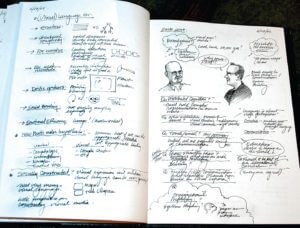Intention Guides Visual Perception
Colin Ware provided the keynote at this year’s VizThink conference in San Jose and a follow-up workshop on “How Do Patterns Structure Visual Thinking.” He’s a researcher from the University of New Hampshire and quite academic, but in his talk I found validation for a growing consensus that intention is the key player in perception.
He began with an inquiry into the primary uses of visual language. I took a lot of notes, which you can read here if you click to magnify. But then he went to the findings from his research.

The bulk of Colin’s talk was sharing his research on how people carry out what he calls “visual queries.” By strapping a special headgear on his subject, he can track where they are focusing their visual attention during a complex visual task of finding connections between a network of big companies in the financial services industry and another network in health. A cursor pointing at any of the nodes in a network diagram would highlight all connected to that node. By clicking back and forth one could eventually see which node has the most connections in both networks. Because Colin could track every detail of both eye movement and hand-cursor movement, he could record precisely how a range of subjects went about this task.
Colin’s presentation made it clear that visualization is fundamentally a process. He shared some familiar examples of how our visual field is only in sharp focus at the very center, and we have to move our eyes around to literally fill in the bigger picture. This stochastic movement is guided by something—most fundamentally our task focus or purpose, Colin concludes.
In my own experience I related Colin’s research to doing the number puzzle, Sudoku, where each nine-box quadrant has to be filled in with nine separate numbers that never repeat in any column or row or quadrant. I decide to look at “3s” and suddenly those patterns pop out. I choose to look for “7s” and another set of patterns emerge. My chosen task focus immediately affects my perception.
There are many examples of people not even seeing something at all unless they are looking for it. I had a vivid experience in this as a youth collecting bugs. I was in a field near our house in Bishop for over an hour looking at all the butterflies and grasshoppers, but didn’t really know what I was looking for beyond that. Then I spotted a long, black beetle with an iridescent gold accent on its wing covers. I was so excited, assuming I had spotted something quite rare. Then I saw another one, and then another, and looked around and the field was full of these beetles on nearly every bush. I hadn’t seen even one for the entire time until I knew what I was looking for!
These findings all support Arthur M. Young’s Theory of Process that puts purpose at the starting point of all process—and I would contend, visual process as well. Consciousness and intention guide our complex physical systems. Perhaps this is why naming, titling framing, and taking responsibility for our attitudes and basic orientations to life are so important.
In these times what drives our awareness? Do we collectively see what we look for? How do we as a people come to a new sense of purpose, beyond material exploitation? Will we come to see our interdependence through this current economic crisis? Can we see the gift that this global wake-up call is delivering? My intention is to help organizations and communities see that by working together, and collaborating across boundaries, there is little that we can’t do.
This week a consultant from the State Department was at The Grove in a Strategic Visioning workshop. I was talking to her about the change in government and what it meant. “There is a lot of inertia in big organizations,” I said. “I would expect that having a new administration is not like turning on a light switch.”
“That’s not entirely true,” she replied. “I did observe one thing that was like a light switch. Immediately after the inauguration I noticed that the rhetoric at the top of the department change completely from the rhetoric of fear to the rhetoric of opportunity.”
If Colin Ware’s research holds true, then this is truly good news.


No Comments